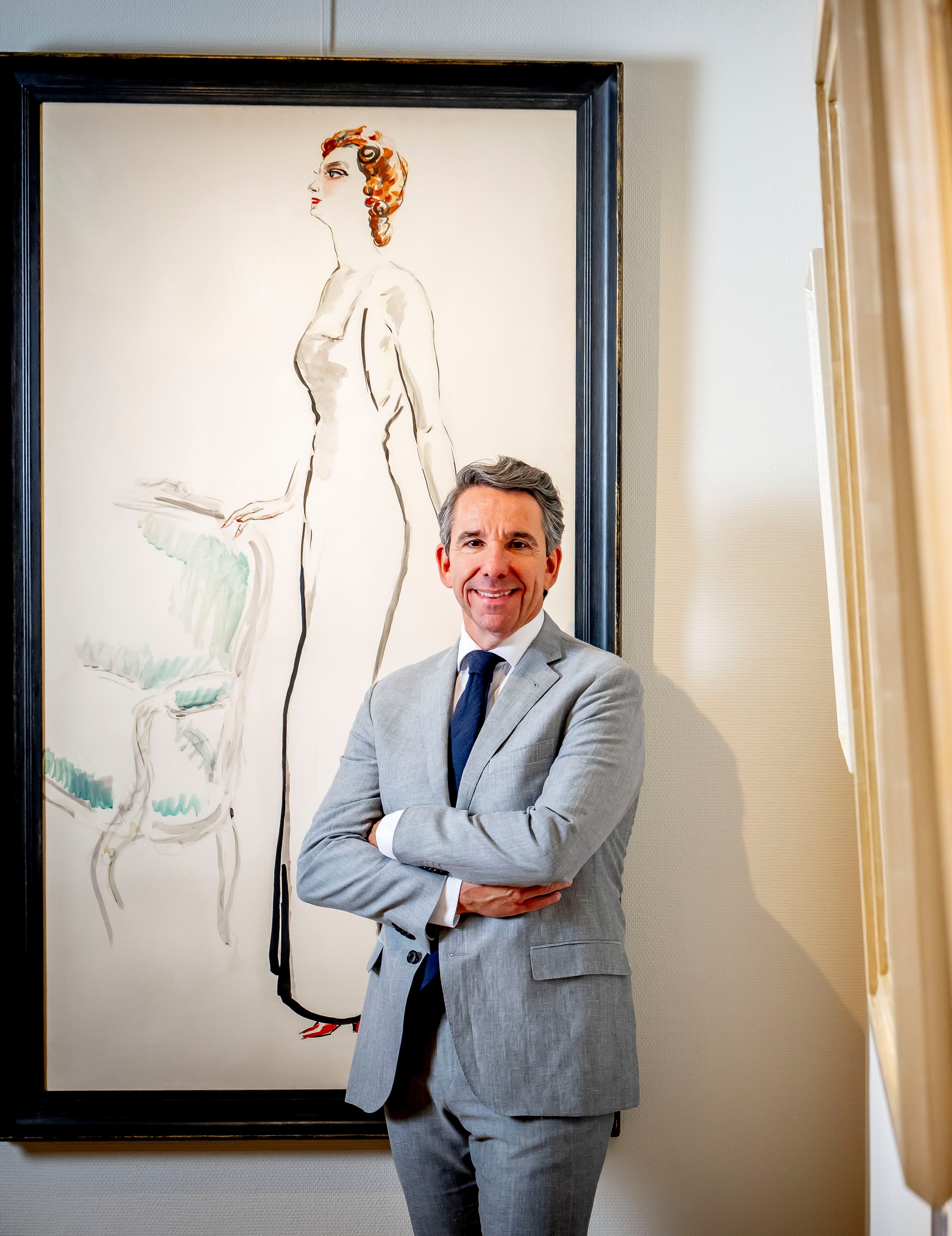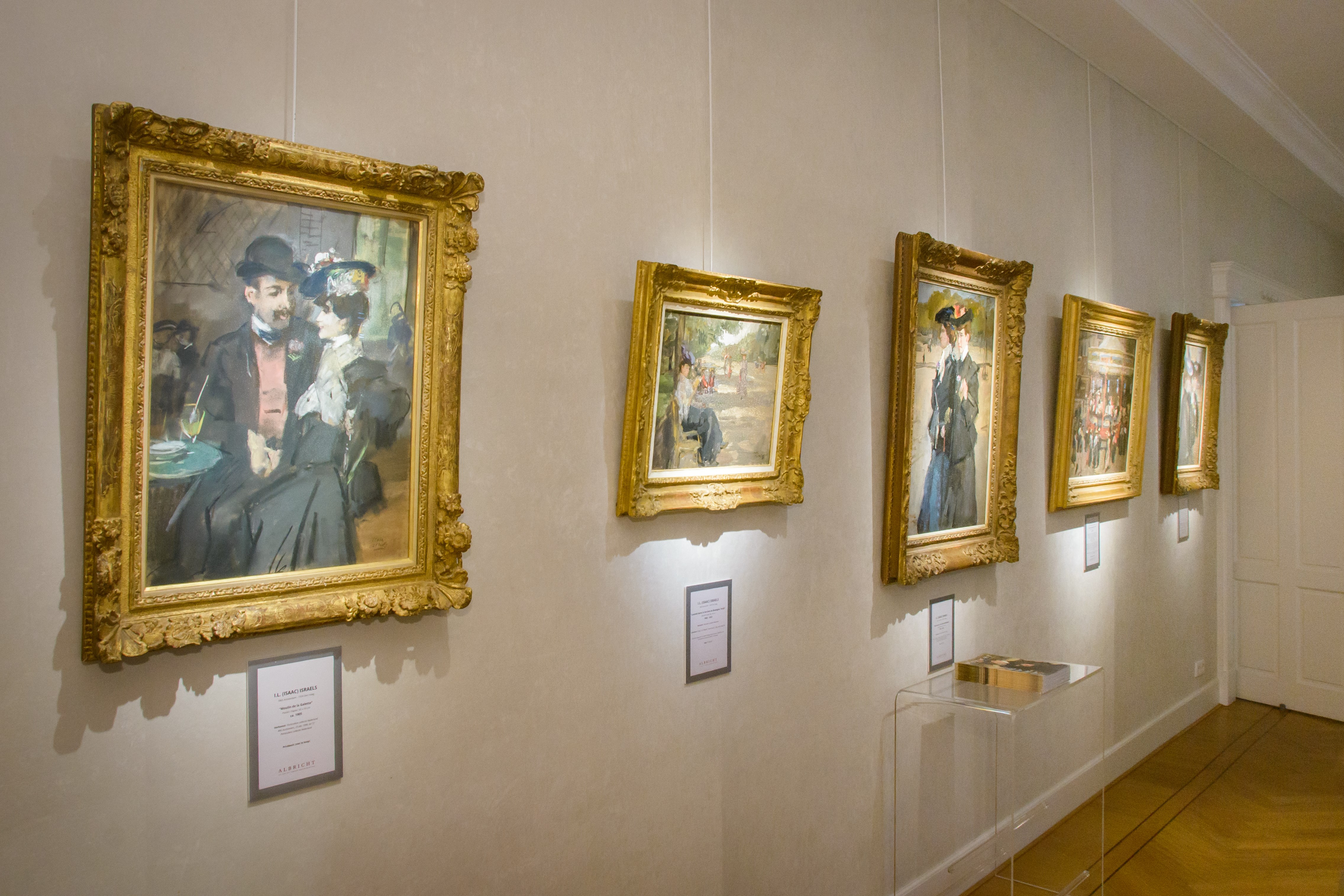The Dutch Eye: Inside the Legacy of Kunstgalerij Albricht
25 July 2025
Share
By Catherine Milner – Treasure House Fair Magazine Editor
In the heart of Oosterbeek, a village renowned for its artistic heritage and wartime history, sits one of the Netherlands’ most respected private art galleries. Kunstgalerij Albricht is housed in a grand 19th-century town hall, just an hour east of Amsterdam. Today, this elegant building is a trove for 19th and early 20th-century Dutch and French master paintings–but in September 1944, it served as a command post and police station during the pivotal Battle of Arnhem.
“It’s an honour to work in such an important place,” says gallery owner Bob Albricht, who joined the family business in 1997 and now celebrates his 28th year as an art dealer. “Oosterbeek, is such a historical place in the Netherlands. Not only as an artists’ colony but also as one of the most important places of the Second World War.”

Bob Albricht with Elegant Lady by C.T.M. (Kees) Van Dongen
The gallery was founded in 1973 by Bob’s father, a passionate collector who turned his love for art into a job. “My father started collecting art as a lover; paintings, antiques, everything” says Bob. “Over the years he traded so much art that at one point he made it his profession.” The business evolved, but its core remained steady. “The basis is still the same as it was 53 years ago: Nineteenth-century Dutch art and early twentieth-century art. Nowadays the focus is a bit more on Impressionism and Modernism.”
Clients–both private collectors and museums from Europe and North America–come to Albricht for guidance not only in buying and selling, but also for appraisals, loans, and advice on shaping their collections. The works on sale span a broad range, from 19th century masters of the Dutch Hague School to early 20th-century painters such as Jan Sluijters and Kees van Dongen, representing the vibrant evolution of Dutch art into Modernism. “The Netherlands has produced many pioneers. I think the entrepreneurial nature is in our DNA–then and now,” says Bob.

Kunstgalerij Albricht interiors
This pioneering mindset is closely tied to what he calls the “Dutch eye”, a unique way of seeing the world that he says has “Dutch common sense as its basis, combined with an incredible urge to discover.” “The Netherlands has always been a country that has produced innovators, from Rembrandt–the greatest artist that the Netherlands has produced–to Van Gogh and Mondrian. Look at the innovation of Van Gogh; his brushwork, colour and composition choices–unsurpassed and very progressive for his time.”
Other periods in Dutch art are also due for a revival he believes; in particular works by the Dutch Romantics like Barend Cornelis Koekkoek and Cornelis Springer as well as those by Dutch Impressionists like Isaac Israëls whose vibrant beach scenes and bustling urban views, rendered with the dynamic brushwork and naturalistic colour of their French counterparts, captured the fading glamour of fin de siècle elegance. Bob was particularly excited to have brought a vibrant and theatrical Fauvist 1909 painting of a dancer in Paris by Kees van Dongen to this year’s Fair. He also presented works by some of the Netherlands’ most groundbreaking artists from the 1940s onward. Movements like CoBrA—featuring Dutch artists such as Karel Appel—demonstrated how deeply Dutch artists have contributed to and shaped pan-European conversations in art.
“Artists have always looked back in time for inspiration,” Bob reflected. “And I believe the current generation will continue to do the same.” Throughout the Treasure House Fair, Kunstgalerij Albricht stood as a bridge between past and present, local heritage and international reach. “We were proud to have brought almost exclusively Dutch artists to the Fair—but with international allure,” said Bob. That balance of historical depth and global vision has sustained the gallery’s relevance for over 50 years—and continues to make its legacy, like the historic building it inhabits, enduringly significant.
(1)_T638859483662641343.JPG)
Kunstgalerij Albricht housed in a grand 19th-century town hall
In the heart of Oosterbeek, a village renowned for its artistic heritage and wartime history, sits one of the Netherlands’ most respected private art galleries. Kunstgalerij Albricht is housed in a grand 19th-century town hall, just an hour east of Amsterdam. Today, this elegant building is a trove for 19th and early 20th-century Dutch and French master paintings–but in September 1944, it served as a command post and police station during the pivotal Battle of Arnhem.
“It’s an honour to work in such an important place,” says gallery owner Bob Albricht, who joined the family business in 1997 and now celebrates his 28th year as an art dealer. “Oosterbeek, is such a historical place in the Netherlands. Not only as an artists’ colony but also as one of the most important places of the Second World War.”

Bob Albricht with Elegant Lady by C.T.M. (Kees) Van Dongen
The gallery was founded in 1973 by Bob’s father, a passionate collector who turned his love for art into a job. “My father started collecting art as a lover; paintings, antiques, everything” says Bob. “Over the years he traded so much art that at one point he made it his profession.” The business evolved, but its core remained steady. “The basis is still the same as it was 53 years ago: Nineteenth-century Dutch art and early twentieth-century art. Nowadays the focus is a bit more on Impressionism and Modernism.”
Clients–both private collectors and museums from Europe and North America–come to Albricht for guidance not only in buying and selling, but also for appraisals, loans, and advice on shaping their collections. The works on sale span a broad range, from 19th century masters of the Dutch Hague School to early 20th-century painters such as Jan Sluijters and Kees van Dongen, representing the vibrant evolution of Dutch art into Modernism. “The Netherlands has produced many pioneers. I think the entrepreneurial nature is in our DNA–then and now,” says Bob.

Kunstgalerij Albricht interiors
This pioneering mindset is closely tied to what he calls the “Dutch eye”, a unique way of seeing the world that he says has “Dutch common sense as its basis, combined with an incredible urge to discover.” “The Netherlands has always been a country that has produced innovators, from Rembrandt–the greatest artist that the Netherlands has produced–to Van Gogh and Mondrian. Look at the innovation of Van Gogh; his brushwork, colour and composition choices–unsurpassed and very progressive for his time.”
Other periods in Dutch art are also due for a revival he believes; in particular works by the Dutch Romantics like Barend Cornelis Koekkoek and Cornelis Springer as well as those by Dutch Impressionists like Isaac Israëls whose vibrant beach scenes and bustling urban views, rendered with the dynamic brushwork and naturalistic colour of their French counterparts, captured the fading glamour of fin de siècle elegance. Bob was particularly excited to have brought a vibrant and theatrical Fauvist 1909 painting of a dancer in Paris by Kees van Dongen to this year’s Fair. He also presented works by some of the Netherlands’ most groundbreaking artists from the 1940s onward. Movements like CoBrA—featuring Dutch artists such as Karel Appel—demonstrated how deeply Dutch artists have contributed to and shaped pan-European conversations in art.
“Artists have always looked back in time for inspiration,” Bob reflected. “And I believe the current generation will continue to do the same.” Throughout the Treasure House Fair, Kunstgalerij Albricht stood as a bridge between past and present, local heritage and international reach. “We were proud to have brought almost exclusively Dutch artists to the Fair—but with international allure,” said Bob. That balance of historical depth and global vision has sustained the gallery’s relevance for over 50 years—and continues to make its legacy, like the historic building it inhabits, enduringly significant.
(1)_T638859483662641343.JPG)
Kunstgalerij Albricht housed in a grand 19th-century town hall

